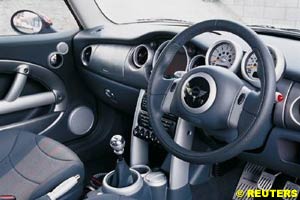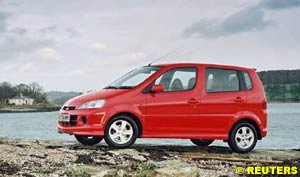

Automotive News and Reviews for the Petrolhead
Reuters Motoring Commentator
In this week's issue:
- Mini to the Max
- Good Wholesome Fare
When you are smitten by the Mini bug, it's all too easy to get carried away.
Everyone wants to personalise their new Mini, and typically spend £1,500-2,000 on options. One customer who bought a Mini Cooper S with the John Cooper Works kit specified so many options the total bill reached an astronomical £35,000!
Move inside and the list can include a satellite navigation system with a colour LCD screen, trip computer or a fully-integrated portable iPAQ Personal Digital Assistant. There is even a new range of bespoke luggage designed by Samsonite to fit snugly into the boot your new MINI.
If you really want to stand out from the crowd, however, your best option might be to go for the Schnitzer-modified Mini. Fast, low and sophisticated, it takes the Mini into a new dimension.
Bitz'o Schnitzer
Tweaking standard production cars is not always the best of ideas. Some, like the BMW M3 and various AMG-modified Mercedes' can be masterpieces. Others, such as the various turbocharged Escort XR3s produced by swarms of aftermarket specialists were disasters. The factory built Ford Fiesta RS Turbo was even worse, with far too much power for safe use by even the most experienced driver.
So what does one make of the German aftermarket specialists Schnitzer? The name is unfamiliar to most enthusiasts in the UK, so it is probably worth reviewing the credentials of the Munich-based firm.
The company began life in 1936 as a humble garage and driving school and became a BMW dealership thirty years later. In 1982 Herbert Schnitzer - son of the company founder - established a tuning and road car development business.
Over the 21 years that have followed, the company has built up an impressive pedigree including running the victorious BMW Motorsport cars at Le Mans, as well as competing in the British and European Touring Car Championships. Its racing ethos is clear from the fact that all its modified road cars are tested on the daunting 14 mile Nurburgring race circuit during development.
Unlike M-Tech, which makes the M3 and M5, Schnitzer's work is not done in BMW factories. Its cars are not sold through BMW showrooms either. But ask your friendly BMW salesman for a Schnitzer brochure and he will be more than happy to sell you gearknobs, wheels, spoilers and all manner of other Schnitzer aftermarket products.
For complete Schnitzer-modified cars, however, you have to go to Schnitzer Sportscars Ltd. The UK agency was set up by racing drivers Tom Ferrier and James Hanson. Having competed in the European Touring Car Championship, they were both sufficiently impressed by Schnitzer's work they bought modified road cars from the firm. Friends and contacts were so impressed by the cars the two race drivers found themselves passing on orders worth almost £1m to the German firm and decided to become UK agents.
What's the Difference?
Schnitzer modified versions of all BMW models are set to arrive over the coming months, but first to arrive is the 200bhp Schnitzer Mini. At first glance, the vehicle sounds suspiciously like the Mini Cooper S Works. The 1.6-litre engine is supercharged to pump up the power by 23% to 200bhp and the torque rises by 14% to 177lb/ft. The figures for the two cars are identical. So too is the 0-60mph time of 6.8 seconds. So where's the difference?
Refinement: That's where.
It doesn't sound much on paper. But out on the road, the difference is considerable. The adrenalin-pumped Works S is a high-rev screamer. The Schnitzer is a weight-lifter in a dinner jacket. If you like your performance raw and unadulterated, the Works S is the car for you. If you travel longer distances or like to talk with your passengers, the Schnitzer is the better choice.
That's not to say the Schnitzer is a softie. With stiffer springs it rides three inches lower and offers pin-sharp handling responses. "The balance and control is better than lots of cars I've raced on track," agrees Ferrier.
Good job he doesn't have to sit in the back. The lowered sports suspension is accompanied by five-spoke 17" alloy wheels shod with 205/45R Pirelli tyres. With so much less suspension travel, rear seat passengers could easily find their heads hitting the roof as the car over bumps. Complaints would have to be loud to persuade the driver to slow down, though. With grip and grunt like this, the responsive Schnitzer Mini is quick and fun - addictively so!
Looks the Business
You can spot a supercharged Mini from the air intake on the bonnet and the Cooper Works S gains deeper front and rear spoilers and a fairly basic side skirts. The Schnitzer styling pack goes one step further.
As well as being more rounded and aerodynamic spoilers and skirts, the Schnitzer feels more integrated, with body coloured wing mirrors and - most importantly - the wheelarch extensions being in body colour, rather than black. To emphasise the difference, all 250 special edition Schnitzer Minis also have a black roof and tinted windows. The styling pack also includes pedals, handbrake, gear knob and footrest in alloy - together with a black or alloy rimmed bonnet scoop.
It all adds up to a tempting package. Customers can select the performance upgrade for £3,480, the handling modifications for £1,655 or the styling pack for £2,440. All the Schnitzer options are approved by BMW, so the Mini's standard warranty is not affected and the Schnitzer components are covered by an unlimited mileage warranty. Sophisticated, sexy and sporty, the Schnitzer option is arguably the best on the list for Mini.
Written by David Sumner Smith
In many ways you could say that we all like food.
As a means of staying alive the concept of eating has proven to be a sound idea and, let's be frank about it, the entire population has been doing it since the earliest days of mankind. None of which means that everyone is actually a food lover.
But these days the subject of eating often appears to have been elevated to some kind of art form. Leading chefs enjoy the same celebrity status as rock stars, movie actors or people who finished third on Big Brother. There are TV shows about how to cook (Delia Smith); how to cook with flair (Rick Stein); how to cook while pouting (Nigella Lawson); and how-to-cook-competitively-even-though-you're-rubbish-at-it (Ready Steady Cook). Some of the best-selling books every year are the latest gastronomic glossaries from Jamie, Gary or Gordon.
And the same is true of cars. For some people, those automotive gourmets of the world, the car is yet another artistic manifestation; a cherished celebration of engineering excellence and stirring sensuality with the bonus of having a practical purpose. And yet to others, the car is little more than a convenient means to an end that is required to do little more than start, move and stop with maximum safety and minimum cost. Which is fair enough, each to their own, and just to show that there are no hard feelings, I'd like to recommend a vehicle to anyone who counts him or herself among this number.
A Surprise Package
It is the Daihatsu YRV. It is a front-wheel drive, four-door mini-MPV that seats five and comes in six different 'flavours', including four-wheel drive and sporty turbo-charged versions. With its high roof and pinched waistline, the YRV looks every inch the urban Japanese micro-mover but is, apparently, aimed at sophisticated European tastes. In truth, its exterior is more than a little misleading; it is positively duplicitous. Daihatsu cite the Volkswagen Golf as a competitor in terms of interior space, but I suspect the YRV would run the Tardis close on internal dimensions. Inside, it defies belief and this is a major factor in establishing this Daihatsu as something of a surprise package.
Another is its pert performance. You can hustle the YRV around with an impudence that is at odds with its diminutive external proportions and although Daihatsu is not keen to draw the comparisons, this car's performance stacks up handsomely against the similarly conceived Mercedes-Benz A Class and Audi A2. Both these compact German people carriers have won critical acclaim and commercial gain but in entry-level guise, neither is as powerful or as nippy as the YRV, even though both have bigger engines. And both cost around four thousand pounds more than the Daihatsu.
Which leads us neatly to the main point. Four thousand pounds is a lot of money but when it's 40% of the ticket price it becomes an awful lot of money. Is the YRV as desirable as the Audi or Mercedes? No, of course it isn't and neither does it feel as robust or well-appointed but then nor are the Mercedes or Audi four thousand pounds better than the Daihatsu. For a fiver under £10,000, the top-of-the-range YRV Premium I tested comes with that clever packaging, including a sensible luggage capacity that can be altered by sliding the rear seat fore and aft, and the zippy performance (109mph/0-62mph 10.3 seconds), together with electric windows all round, remote central-locking, manual air-conditioning, twin air-bags, alloy wheels and an ABS braking system. A decent sense of refinement at motorway speeds and combined-cycle economy figure of 47.1mpg completes an impressive overall specification.
Value for Money
The YRV is small but spacious; nippy and economical; well equipped yet excellent value-for-money. If Ronseal made a car, it would be a YRV and there are buyers who will be more than happy with this, but what kind of buyers are they? Daihatsu's reluctance to draw any comparison with the Mercedes or Audi begins to make sense because these cars are quite probably aimed at wildly different markets.
The Daihatsu is a perfect vehicle for anybody who prioritises practicality and good value ahead of perceived brand image, and which sector of society do we associate these qualities with? Definitely not 'the youth of today' so why has this car been christened the Young Recreational Vehicle? It cannot really be termed exciting (even in sporty turbo-charged guise) nor is it possessing of much in the way of 'street cred', and so aside from being spacious and inexpensive (rarely enough in itself), what is the attraction for young people?
Minimal, I reckon. By design, the YRV is more likely to appeal to an older audience and this means people who don't do much hang-gliding but prefer to sit in and eat soup, listening to the wireless a lot. Which is fair enough. Daihatsu is not a big company (in Britain, Ford sells more cars in one week than Daihatsu will sell all year) but it still manages to support such a market, operating a network of 93 dealers (in places such as Dukinfield and Peebles) and offering one of the best customer service packages available in Britain. As with most Japanese manufacturers, this includes comprehensive warranties against mechanical failures (three years), bodywork corrosion (six years) and paintwork defects (three years).
So the name is a little misleading but everything else about this car is quite genuine. For anyone with a simple palate, or limited funds, the YRV is an excellent idea. It is motorised baked beans; conveniently packaged, satisfying enough and excellent value-for-money. And, dare I say it, just about perfect if you happen to have false teeth.
![]() Mini to the Max
Mini to the Max
 Prices for the Mini range start at just £10,400, but the range of options is so wide it is almost bewildering. As well as nine different types of alloy wheels, parking sensors and Xenon headlights, you can add chequered flag or Union Jack roof decals. There is also an aerodynamic body kit, white finish tail lamps, and xenon headlights.
Prices for the Mini range start at just £10,400, but the range of options is so wide it is almost bewildering. As well as nine different types of alloy wheels, parking sensors and Xenon headlights, you can add chequered flag or Union Jack roof decals. There is also an aerodynamic body kit, white finish tail lamps, and xenon headlights.
 Both John Cooper Works and Schnitzer use the standard supercharged Mini Cooper S as the basis for their efforts. But John Cooper Works increases the rev limit to allow the engine to reach its maximum power at 6950rpm and maximum torque at 4000rpm. Schnitzer, by contrast, changes the exhaust system and the gearing of the supercharger. Maximum torque is delivered at 3600rpm and the power peaks at 6200rpm.
Both John Cooper Works and Schnitzer use the standard supercharged Mini Cooper S as the basis for their efforts. But John Cooper Works increases the rev limit to allow the engine to reach its maximum power at 6950rpm and maximum torque at 4000rpm. Schnitzer, by contrast, changes the exhaust system and the gearing of the supercharger. Maximum torque is delivered at 3600rpm and the power peaks at 6200rpm.
![]() Good Wholesome Fare
Good Wholesome Fare
 And yet most people in Britain, on most nights of the week, will be happy to simply 'knock something up' for their tea. For every salivating gastronome in the land, I suspect that there are at least another nine indifferent Britons whose epicurean aspirations start with mastering the tin opener and end when the microwave door slams shut.
And yet most people in Britain, on most nights of the week, will be happy to simply 'knock something up' for their tea. For every salivating gastronome in the land, I suspect that there are at least another nine indifferent Britons whose epicurean aspirations start with mastering the tin opener and end when the microwave door slams shut.
© 1995-2005 Kaizar.Com, Inc. . This service is provided under the Atlas F1 terms and conditions.
|
Volume 9, Issue 26
Atlas F1 Exclusive
Interview with Allan McNish
Giancarlo Fisichella: Through the Visor
Atlas F1 Special
Tifoso IPO
Articles
Season in the Sun: Part V
European GP Preview
European GP Preview
Europe and France Facts & Stats
Columns
The F1 Trivia Quiz
Bookworm Critique
On the Road
Elsewhere in Racing
The Weekly Grapevine
> Homepage |